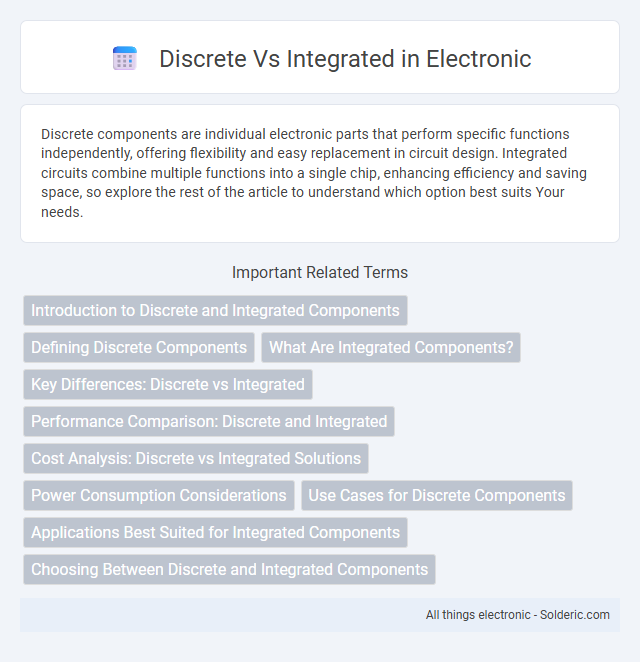Discrete components are individual electronic parts that perform specific functions independently, offering flexibility and easy replacement in circuit design. Integrated circuits combine multiple functions into a single chip, enhancing efficiency and saving space, so explore the rest of the article to understand which option best suits Your needs.
Comparison Table
| Feature | Discrete | Integrated |
|---|---|---|
| Definition | Separate individual components | Multiple components combined in one unit |
| Performance | Higher, specialized for tasks | Moderate, balanced for general use |
| Cost | Higher due to separate parts | Lower, cost-effective |
| Power Consumption | Higher power usage | Lower power usage |
| Heat Generation | More heat generated | Less heat generated |
| Upgradeability | Easy to upgrade individual parts | Limited upgrade options |
| Size | Larger physical footprint | Compact design |
| Use Case | Gaming, professional workstations | Everyday computing, laptops |
Introduction to Discrete and Integrated Components
Discrete components are individual electronic parts such as resistors, capacitors, and transistors, each serving a specific function in a circuit. Integrated components, known as integrated circuits (ICs), combine multiple discrete components into a single semiconductor chip to perform complex tasks efficiently. The choice between discrete and integrated components impacts circuit design, size, power consumption, and overall performance.
Defining Discrete Components
Discrete components are individual electronic parts with distinct functions, such as resistors, capacitors, and transistors, each packaged separately. These components enable precise control and customization in circuit design, offering advantages in repairability and performance tuning. Discrete components contrast with integrated components, which combine multiple functions into a single chip to save space and increase complexity.
What Are Integrated Components?
Integrated components combine multiple electronic functions or circuits into a single chip or module, enhancing efficiency and reducing space in devices such as smartphones and laptops. Unlike discrete components, which perform individual tasks separately, integrated components optimize performance by minimizing signal loss and improving reliability. Your choice between discrete and integrated components depends on the specific application requirements, including size constraints, power consumption, and cost.
Key Differences: Discrete vs Integrated
Discrete components are individual electronic elements such as resistors, capacitors, and transistors, designed to perform specific, singular functions within a circuit. Integrated components, or integrated circuits (ICs), combine multiple discrete elements into a single chip, enabling complex functions and minimizing space requirements. The key differences lie in size, cost-effectiveness, performance consistency, and application complexity, with integrated circuits offering enhanced efficiency and scalability compared to discrete parts.
Performance Comparison: Discrete and Integrated
Discrete graphics cards typically offer superior performance compared to integrated graphics due to dedicated GPU resources and higher memory bandwidth. Integrated graphics share system memory and processing power, resulting in limited capabilities for demanding tasks like gaming or 3D rendering. Benchmarks reveal discrete GPUs consistently achieve higher frame rates and better handling of complex visual workloads than their integrated counterparts.
Cost Analysis: Discrete vs Integrated Solutions
Discrete solutions typically incur higher costs due to multiple individual components requiring separate manufacturing, assembly, and maintenance, leading to increased material and labor expenses. Integrated solutions offer cost savings by combining functions into a single chip, reducing production complexity, space, and power consumption, which lowers overall system costs. Your choice affects budget allocation, with integrated designs favored in mass production for their efficiency and discrete systems preferred for flexibility and customization.
Power Consumption Considerations
Discrete power components typically consume more power due to inefficiencies in external connections and separate voltage regulation. Integrated power solutions optimize energy use by combining multiple functions within a single chip, reducing current leakage and minimizing power loss. Effective power consumption management in integrated circuits extends battery life and improves overall system efficiency in portable and embedded devices.
Use Cases for Discrete Components
Discrete components excel in applications requiring precise control, customization, and easy troubleshooting, such as in RF circuits, audio equipment, and power management systems. They enable designers to optimize performance by selecting individual parts tailored to specific functions, enhancing flexibility in prototyping and repair. Your projects benefit from improved reliability and scalability when using discrete components in high-frequency or high-power scenarios.
Applications Best Suited for Integrated Components
Integrated components excel in applications requiring compact design, high reliability, and minimized signal loss, such as smartphones, laptops, and wearable devices. Their ability to combine multiple functions into a single package reduces overall space and power consumption, making them ideal for complex consumer electronics and IoT devices. High-density integration facilitates faster processing speeds and improved thermal management, crucial for modern communication systems and embedded technology.
Choosing Between Discrete and Integrated Components
Choosing between discrete and integrated components depends on your project's requirements for performance, cost, and space. Discrete components offer greater customization and easier troubleshooting, while integrated components provide compactness and improved efficiency. Prioritizing your design goals helps determine whether to opt for flexibility or system simplification.
Discrete vs Integrated Infographic

 solderic.com
solderic.com